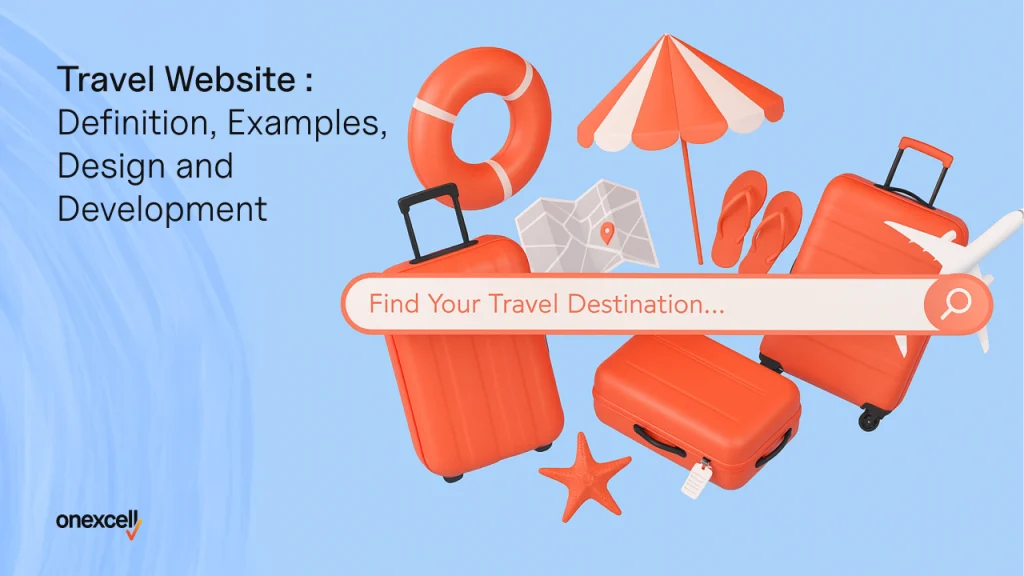A travel website is an interactive digital platform that enables users to explore destinations, compare options, and book travel-related services such as flights, accommodation, tours, and car rentals online. These platforms serve the travel and hospitality industries by enhancing customer convenience and automating reservations, which improves operational efficiency.
Key features of travel websites include comprehensive search and filtering options, integration with booking engines and payment gateways like Stripe and PayPal for secure transactions, real-time inventory updates to prevent overbooking, mobile-optimised designs, multilingual support, user review systems, and personalised recommendations. Many travel websites incorporate interactive maps, travel guides, and itinerary planners to enrich the user experience.
According to a 2024 industry report, 65% of all travel bookings were made online, with 68% of travel website traffic coming from mobile devices, emphasising the critical role of responsive, user-friendly travel websites. Moreover, websites ranking on the first page of Google capture over 75% of clicks, highlighting the importance of SEO and content marketing for travel platforms.
Examples of successful travel websites include Expedia, Booking.com, Airbnb, Kayak, and Travelocity, each known for their extensive inventories, intuitive interfaces, and better booking experiences.
Designing a travel website involves defining the target audience and purpose, researching competitors, creating wireframes and layouts focused on intuitive navigation and responsive design, and incorporating essential features such as booking forms and review sections. Development steps include selecting a CMS or custom platform, integrating backend booking systems and payment processing, optimising for SEO and mobile devices, followed by thorough testing and launch.
The cost of developing a travel website varies, as basic sites using templates and plugins cost between £0 and £175, while custom-built platforms with advanced booking engines and integrations range from £5,300 to £14,300, with highly customised solutions exceeding £20,000. Ongoing maintenance and security updates generally add £400 to £1,600 annually.
By combining robust technology, user-centric design, and strategic marketing, travel websites deliver engaging, efficient, and secure experiences that meet the evolving needs of modern travellers and businesses alike.
What is a Travel Website?
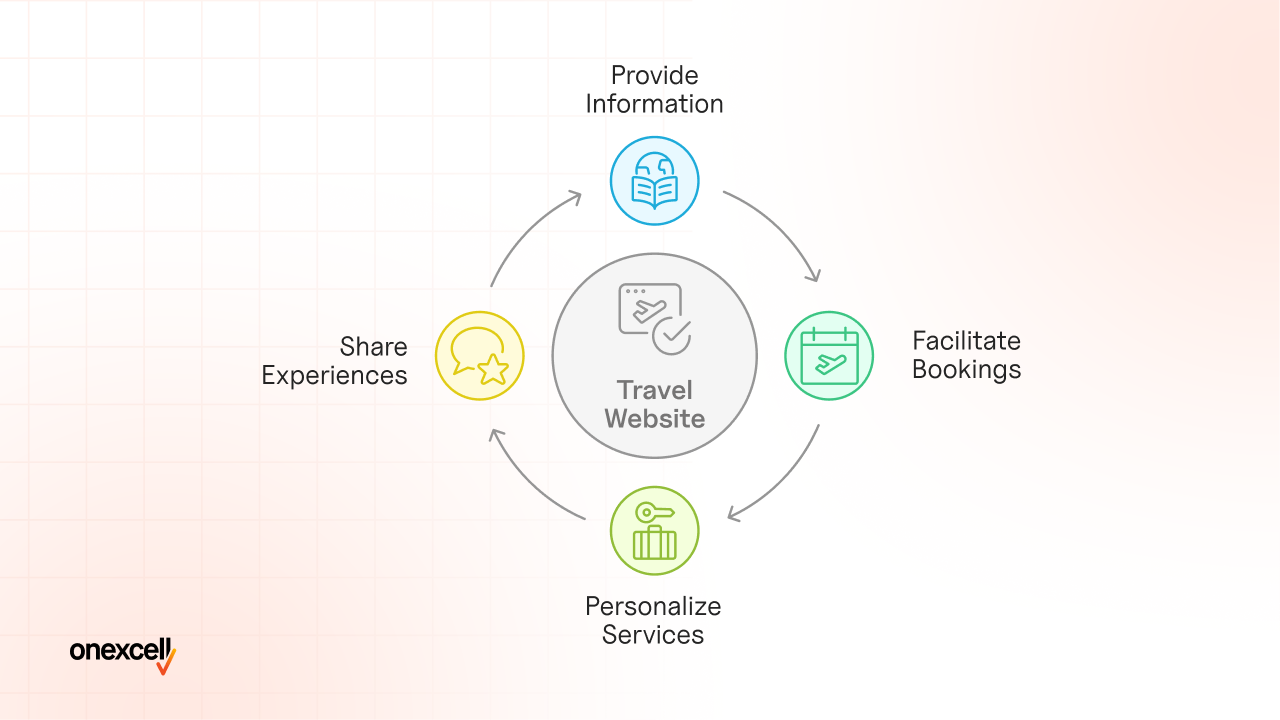
A travel website is an online platform designed to provide information, resources, and services related to travel and tourism, serving as a central hub for trip planning, research, and booking. The purpose of a travel website is to empower travellers to make informed decisions by offering destination guides, travel tips, and itineraries, as well as tools for comparing and booking flights, accommodation, car rentals, and activities. These websites provide a travel planning process that enables users to conveniently organise and manage their journeys from start to finish.
Informational travel websites focus on delivering destination insights, cultural highlights, and travel inspiration through articles, photos, and guides. Booking websites and online travel agencies (OTAs) such as Expedia or Booking.com allow users to search, compare, and reserve flights, hotels, and tours in real time.
Travel agency websites combine personalised service with digital tools, helping clients customise trips and access expert advice. Review-based travel websites, like TripAdvisor, provide user-generated reviews and ratings, offering authentic perspectives on destinations, accommodation, and attractions.
The role of a travel website is to simplify and enrich the trip planning experience by aggregating travel information, facilitating secure bookings, and a community where travellers share experiences and recommendations. This makes travel websites indispensable for anyone to explore new destinations, find the best deals, and create memorable journeys with confidence.
What are the main benefits of having a travel website?
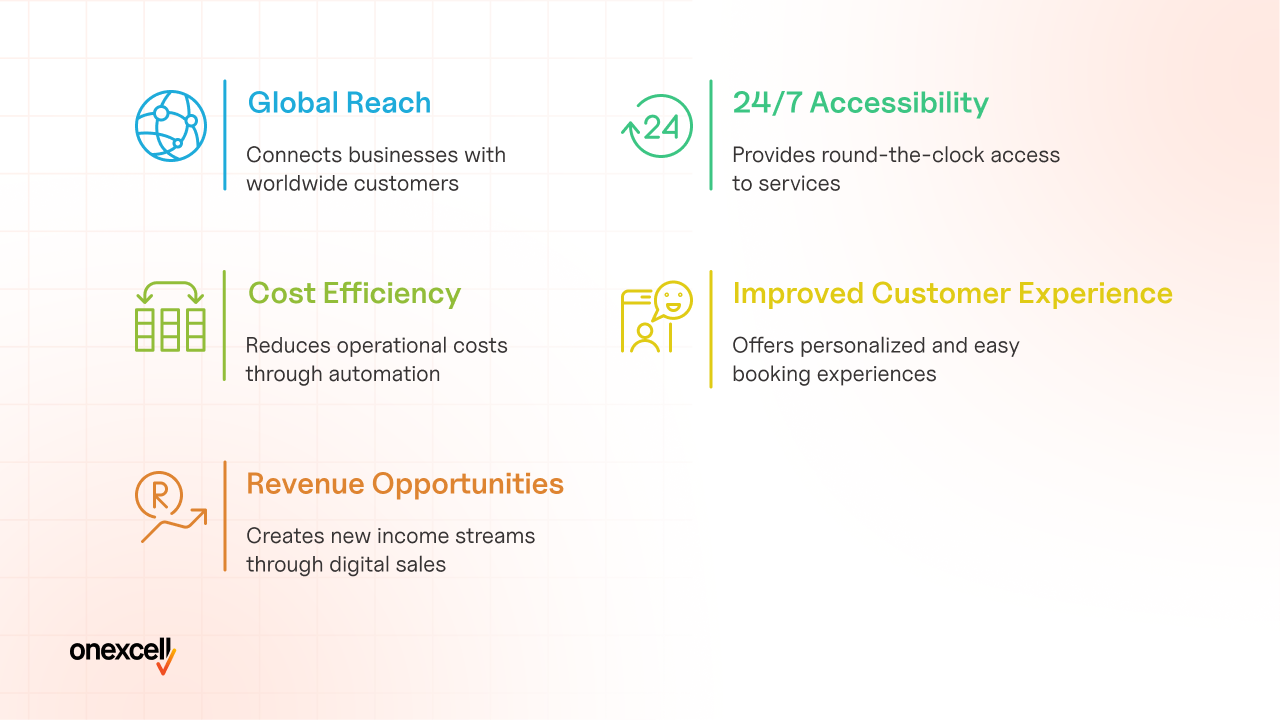
The main benefits of having a travel website are listed below.
- Global Reach
A travel website allows businesses to connect with customers worldwide, breaking geographical barriers and tapping into the $1.2 trillion global online travel market projected for 2027. With 82% of all travel bookings made online, even small operators attract international travellers and expand their customer base. - 24/7 Accessibility
Travel websites provide round-the-clock access to information, booking, and customer service. This is essential, as 80% of global travellers say it’s important to book trips entirely online, and 72% now prefer to do so, to make sure bookings and enquiries happen at any time, regardless of time zones. - Cost Efficiency
By automating booking processes and reducing the need for physical offices or call centres, travel websites lower operational costs. Digital bookings also streamline customer service and payment handling, helping businesses allocate resources more efficiently. - Improved Customer Experience
Online travel platforms offer personalised recommendations, easy comparison tools, and instant confirmations, which are highly valued by travellers90% expect a personalised experience when booking online. A positive website experience is a key driver of overall travel satisfaction and repeat business. - Revenue Opportunities
Travel websites create new revenue streams through upselling, cross-selling, and dynamic pricing. Digital travel sales are growing at 15.4% annually, and hotel websites account for two-thirds of all digital travel booking revenues. Travel websites that invest in user experience are better positioned to capture market share and drive higher conversion rates.
What design elements make a travel website stand out?
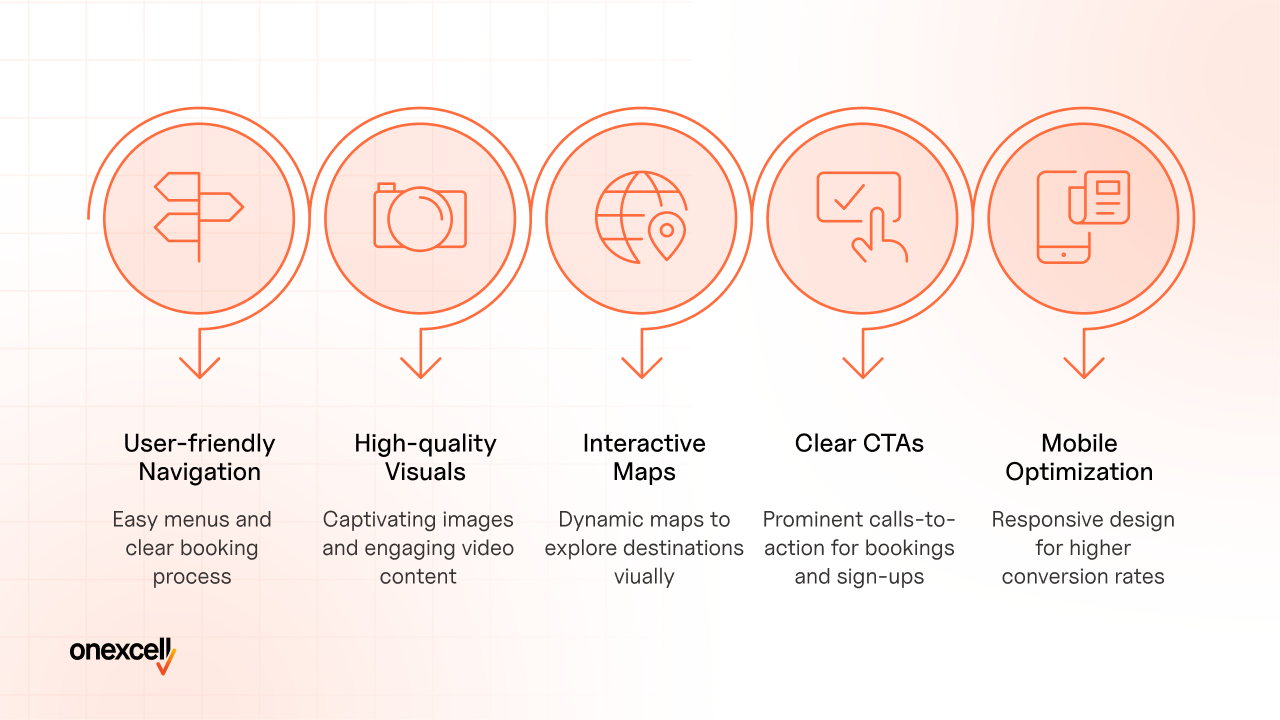
The elements that will make a travel website stand out are those that combine striking aesthetics with better functionality, directly impacting user engagement and conversion rates.
Below are the design elements to make a travel website stand out.
- User-friendly Navigation
Intuitive menus, clear categorisation, and streamlined booking funnels help users find information and complete reservations quickly. Studies show that poor navigation drives 79% of visitors away, while well-organised sites keep users engaged and increase the likelihood of bookings. - High-quality Visuals
Captivating imagery and video content are essential for inspiring wanderlust and building trust. Over 54% of consumers say appealing visuals influence their perception of a brand, and consumers favour images over other types of visual elements on business websites. Airbnb, for example, is renowned for its high-quality photos and video tours, which contribute to its conversion success. - Interactive Maps
Integrating dynamic maps allows users to explore destinations, accommodations, and attractions visually, enhancing engagement and helping travellers plan more effectively. Interactive content like maps and filters signifitly improve the user experience and encourage deeper exploration of offerings. - Clear Calls-to-Action (CTAs)
Prominently placed and visually distinct CTAs guide users toward booking, enquiries, or newsletter sign-ups. Research indicates that strong CTAs and minimalist layouts boost conversion rates by reducing friction in the booking process. - Mobile Optimisation
Around 90% of websites have implemented responsive design, and mobile-optimised sites see 40% higher conversion rates.
How high-quality visuals enhance user engagement?
High-quality visuals enhance user engagement by immediately capturing attention, evoking emotion, and inspiring users to explore travel offerings more deeply. Professional images, immersive videos, and virtual tours allow potential travellers to vividly imagine themselves at a destination, which increases both emotional connection and trust in the brand.
High-resolution, original photographs reduce bounce rates and encourage users to spend more time on travel websites, as they are more likely to browse additional pages and interact with content. Travel sites that prioritise visual storytelling and feature authentic, relatable imagery see higher engagement and conversion rates, with users more likely to book after viewing compelling visuals.
What are Examples of Successful Travel Websites?
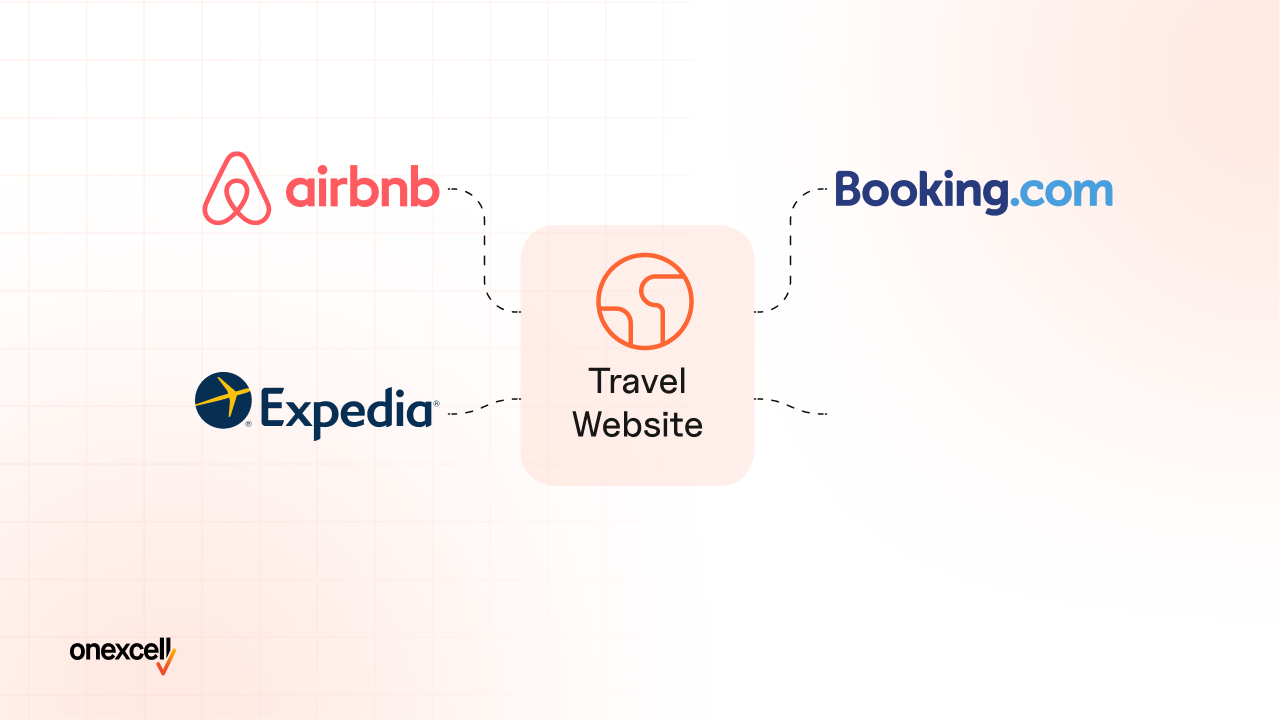
Some of the most successful travel websites include Booking.com, Expedia, Airbnb, and TripAdvisor. These travel brands are recognised for their user-friendly interfaces, global reach, and innovative digital travel services that streamline the booking process for millions of users.
Below are examples of successful travel websites.
1. Booking.com
2. Expedia
3. Airbnb
4. TripAdvisor
- Booking.com
Booking.com is a leading travel booking site that offers access to millions of hotels, apartments, and holiday rentals worldwide. Known for its real-time availability, competitive pricing, verified guest reviews, and better reservation process, Booking.com makes it easy for travellers to find and book accommodation that suits their needs.
- Expedia
Expedia is a comprehensive online travel agency that allows users to book flights, hotels, car hire, and holiday packages. Its integrated platform enables travellers to bundle services for discounts, manage multi-city itineraries, and access last-minute deals, making it a flexible and convenient solution for planning trips.
- Airbnb
Airbnb revolutionised the travel industry by connecting travellers with hosts offering unique accommodation, from city apartments to countryside retreats. The platform emphasises personalised experiences, secure payment systems, and a robust community review system, helping guests find one-of-a-kind stays around the world.
- TripAdvisor
TripAdvisor is a trusted travel website that combines booking capabilities with millions of user-generated reviews and ratings. Travellers use TripAdvisor to research destinations, compare hotels, restaurants, and attractions, and make informed booking decisions based on real traveller feedback and rankings.
How are Travel Websites Designed?
Travel website design is carried out through a structured web design process that emphasises both user experience (UX) and user interface (UI) principles to meet the needs of modern travellers and drive business results. The process begins with wireframing, where designers create detailed website wireframe blueprints that map out the layout, navigation, and placement of key elements such as search bars, booking forms, filters, and image galleries. These wireframes help every section of the site serve a clear purpose and support intuitive navigation for individual users.
Travel website user interface design focuses on creating visually appealing and interactive elements, including high-quality destination images, clear call-to-action buttons, and easy-to-read fonts. Professional website design services make sure that every visual component supports usability and aligns with the brand’s identity. Designers prioritise a clean, professional look by using consistent colour schemes and branding elements to reinforce recognition and trust.
Travel website performance is enhanced by fast-loading web pages, which are a top priority, as slow sites lead to higher bounce rates and lost bookings. Developers optimise images, streamline code, and leverage content delivery networks for quick load times, enhancing the overall user experience and keeping visitors engaged.
Advanced filtering options and search functionality allow individual travellers to quickly find relevant destinations, accommodation, or packages based on their preferences, while user-friendly navigation bars and menus help users move effortlessly through the site’s sections.
Travel website functionality is further supported by additional features such as interactive maps, user reviews, booking engines, and secure payment gateways which are integrated to provide a comprehensive and trustworthy platform.
What are the Steps to Developing a Travel Website?
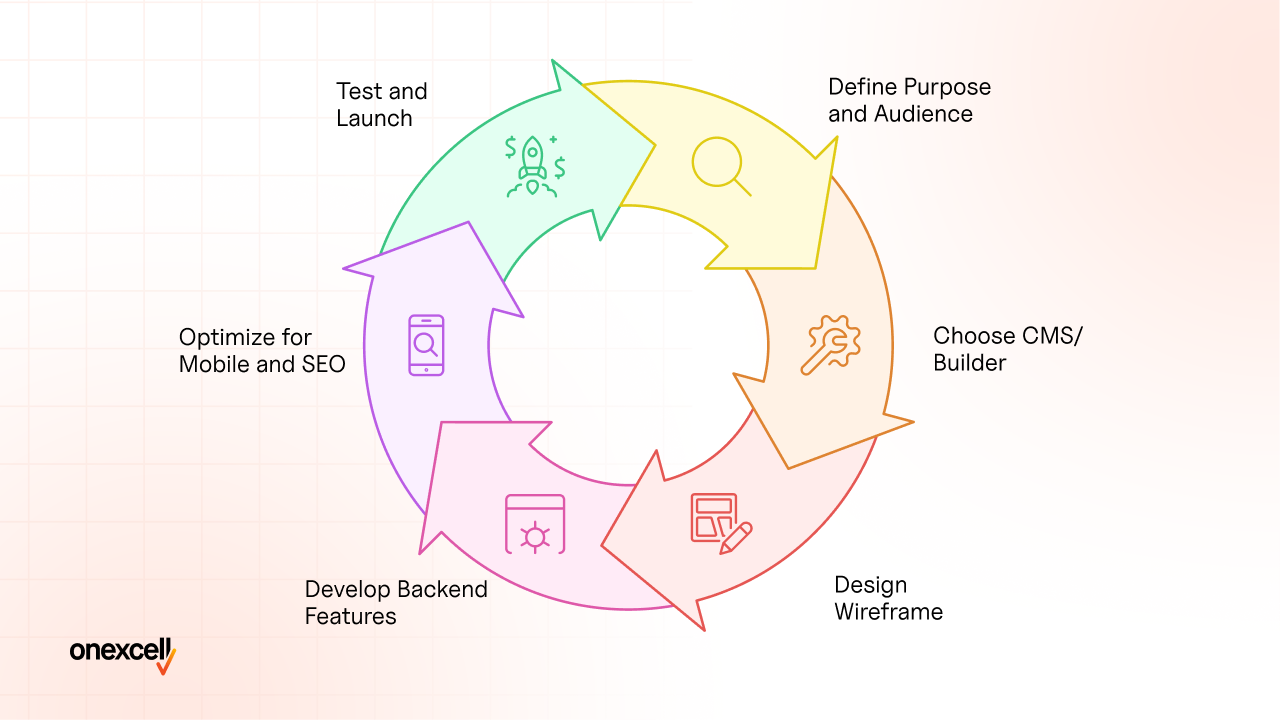
The key steps in developing a travel website are essential for creating a platform that is both user-friendly and effective in delivering travel services. Professional web development services for smooth navigation, efficient booking processes, and secure payment handling while managing reservations and customer interactions.
Below are the steps to develop a travel website.
1. Define the website’s purpose and audience.
2. Choose a CMS or website builder.
3. Design wireframes and layouts.
4. Develop backend features (booking systems, payment integration).
5. Optimize for mobile and SEO.
6. Test and launch the website.
- Define the website’s purpose and audience
Begin by identifying the primary goals of your travel websites whether to facilitate hotel bookings, provide travel guides, or offer package deals and define the target audiences such as leisure travellers, business tourists, or adventure seekers. Understanding the demographics, preferences, and behaviours of your potential users will guide the design choices and feature sets needed to meet their expectations.
- Choose a CMS or website builder
Select appropriate CMS platforms or website builders that align with your technical expertise, budget constraints, and scalability requirements. Popular CMS options include WordPress with travel-specific plugins, Drupal, or Joomla, while website builders like Wix, Squarespace, or Shopify offer integrated tools and templates for travel web platforms. These solutions provide flexibility in managing content, bookings, and customer data efficiently.
- Design wireframes and website layouts
Create detailed wireframes and website layouts that outline the structure, navigation flow, and placement of critical elements such as search bars, filters, booking forms, image galleries, and call-to-action buttons. These visual blueprints help travel web platforms offer intuitive user experiences and logical content organisation, facilitating easy exploration and reservation by visitors.
- Develop back-end features
Implement or integrate essential back-end components including real-time booking engines, secure payment gateways, user authentication systems, and content management tools. These back-end features enable travel websites to handle reservations, process transactions, manage availability calendars, and provide automated confirmations for a better and reliable service for both users and administrators.
- Optimise for mobile devices and SEO
Travel websites are fully responsive and optimised for mobile devices, as a portion of travel bookings occur via smartphones and tablets. Employ SEO best practices such as keyword optimisation, meta descriptions, fast page load speeds, and structured data to improve search engine rankings and increase organic traffic to the travel platforms.
- Test and launch the website
Conduct comprehensive testing across multiple devices, browsers, and user scenarios to identify and resolve any usability issues, bugs, or performance bottlenecks. Test critical workflows including search functions, booking processes, payment transactions, and navigation. After successful testing, launch the travel websites and continuously monitor performance, making iterative improvements to enhance user satisfaction and business outcomes.
What is the cost of developing a travel website?
The cost of developing a travel website ranges from £10,000 and £100,000 depending on how many modules you want to integrate, including the choice between bespoke development and pre-built templates, the number and complexity of third-party integrations such as booking engines and payment gateways, and the ongoing maintenance required to keep the platform secure and up to date.
A basic travel website with standard booking functions, costs range from £5,300 to £14,300, while leveraging ready-made travel plugins or templates reduce initial expenses to as little as £0 to £175, depending on the features selected. However, incorporating advanced features such as custom logins, complex search filters, or API integrations for flights and hotels increase the total cost to £20,000 or more.
Custom web design, unique visual elements, and ed user experiences generally raise costs compared to using off-the-shelf themes. Integrating third-party APIs for real-time bookings, secure payment processing, and mapping services also contributes to both development and licensing expenses.
Ongoing maintenance including updates, technical support, and security ranges from £400 to £1,600 per year, so the website remains stable and competitive.
Scientific and industry data reinforce the importance of these investments by over 60% of travellers now prefer to book trips online, and the travel e-commerce sector is projected to surpass £640 billion in revenue in 2024, underscoring the financial impact of efficient, user-friendly travel web solutions. Ultimately, website budgeting account for initial design and development, integration of essential travel features, and continuous maintenance to maximise return on investment and meet evolving customer expectations.
What is the best web hosting provider for a travel site?

The best website hosting provider for a travel website is one that delivers fast performance, strong security, and reliable uptime to support the high demands of travel websites, such as multimedia content, real-time booking features, and spikes in visitor traffic.
Below are the best website hosting providers for a travel website.
- Bluehost
Bluehost is a popular choice for travel websites, better for small boutique hotels, bed and breakfasts, or travel blogs. It provides user-friendly setup, better integration with WordPress, reliable uptime, and fast load times all essential for keeping travel website visitors engaged. - SiteGround
SiteGround is highly regarded for travel websites that experience high traffic, such as luxury hotels, resorts, or travel agencies. Its Google Cloud-powered infrastructure for fast load times, daily back-ups, and robust security, making it ideal for travel websites that require reliability and top-notch customer support. - Kinsta
Kinsta specialises in managed WordPress hosting for travel websites with high traffic and dynamic content. It offers scalable resources, advanced security, and performance optimisation,so that travel website users experience better browsing and booking even during peak seasons. - Cloudways
Cloudways provides dedicated resources and flexible cloud hosting for travel websites, making it easy to scale as your travel website grows. With fast load times, enhanced security, and reliable uptime, Cloudways is suitable for travel websites that need both performance and flexibility to handle booking systems and destination content.
How to choose a Travel website CMS?
To choose a travel website CMS, consider key factors like customisation, plugin availability, user-friendliness, and scalability. WordPress is the most popular choice due to its vast ecosystem of travel-specific themes and plugins, ease of use, and strong SEO capabilities, making it ideal for small to medium travel sites.
Joomla offers greater flexibility and built-in multilingual support, suited for travel websites targeting diverse international markets or requiring complex booking features. Drupal excels in scalability, security, and handling large, high-traffic travel platforms but demands more technical expertise.
Selecting the right CMS depends on your travel business’s size, technical resources, and feature needs WordPress for simplicity and extensibility, Joomla for adaptability and multilingual content, and Drupal for robust, enterprise-level solutions.
How do travel websites integrate booking and reservation systems?
Travel websites integrate booking and reservation systems to offer better, real-time access to flights, hotels, and activities, enhancing user experience and boosting conversions. This is achieved through booking engines and third-party travel APIs such as Rezdy and FareHarbor, which provide up-to-date availability, pricing, and inventory. Integration methods include API connections for full customisation, widgets for quick setup, and iFrames for simple embedding.
These travel websites reservation systems synchronise real-time data, enable secure payment processing, and deliver instant confirmations, creating a smooth and reliable booking process that meets modern travellers’ expectations while streamlining operations for travel businesses.
How do responsive designs improve travel website visibility?
A responsive design improves travel website visibility by ensuring that the site automatically adapts to any device, whether desktop, tablet, or smartphone, delivering a better and visually appealing experience for every user. Mobile-friendly layouts and adaptive elements eliminate the need for horizontal scrolling or zooming, making it easier for travellers to find information and complete bookings, which directly enhances user satisfaction and encourages repeat visits.
Fast loading speeds, a hallmark of responsive design, reduce bounce rates and keep visitors engaged, with industry data showing that users are far more likely to abandon a site if it loads slowly or displays poorly on mobile devices.
Google prioritises mobile-friendly and responsive sites in its search rankings due to mobile-first indexing, meaning travel websites that invest in responsive web design services are more likely to appear higher in search results and attract organic traffic.
According to 2023 industry data, 68% of online traffic for travel and hospitality websites came from mobile devices, highlighting the critical importance of responsive design for travel website visibility.
Is SEO important for travel websites?
Yes, SEO is important for a travel website because it directly drives visibility, organic traffic, and bookings in an increasingly competitive online market. Key SEO strategies include on-page SEO, such as keyword optimisation to target what travellers are searching for and producing high-quality, helpful content that meets Google’s ranking factors, as well as technical SEO, which involves optimising site speed, mobile-friendliness, and crawlability. Building authoritative backlinks and implementing local SEO helps capture location-based searches.
According to a 2024 industry report by Screaming Frog, organic search remains the top channel for travel website traffic, with Booking.com alone receiving over 84.6 million visits per month from search engines.
Do travel websites incorporate local SEO to attract regional traffic?
Yes, travel websites incorporate local SEO to attract regional traffic by optimising Google My Business profiles, using location-based keywords, and creating location-specific content that targets travellers searching for nearby destinations or services.
Travel websites also leverage local directory listings, backlinks from regional sites, and customer reviews to boost local search rankings and credibility. According to industry data, local SEO increases visibility in the “Local Pack” and drives higher conversion rates, as travellers performing geo-targeted searches are more likely to book with businesses that appear prominently in local results.
What role does content marketing play in the success of a travel website?
Content marketing plays an important role in the success of a travel website by attracting, engaging, and converting travellers through strategic storytelling, valuable information, and authentic experiences. Effective strategies include publishing blogs and travel guides that answer audience questions and showcase unique destinations, leveraging social media marketing to share visually compelling content, and collaborating with influencers to expand reach and credibility.
Travel websites that segment their audiences and content such as destination-specific guides, interactive quizzes, and local expert interviews connect more deeply with different traveller types and inspire action. High-quality, SEO-optimised content improves search visibility and drives organic traffic, while user-generated content, loyalty programmes, and exclusive offers foster ongoing engagement and repeat bookings.
According to industry data, 81% of marketers report that content marketing grows brand awareness, and 74% of travellers use online platforms to plan trips, underscoring content’s power to build trust, boost bookings, and establish a travel website as an authority in a competitive market.
What security features should be included in travel websites?
The security features to include in a travel website are listed below.
- SSL Encryption: A travel website encrypts all data transmitted between users and the site, protecting sensitive information such as personal details and payment data from interception or theft.
- Secure Payment Gateways: A travel website integrates trusted payment processors that comply with PCI DSS standards to safely handle credit card transactions and prevent fraud.
- Multi-Factor Authentication (MFA): A travel website adds an extra layer of user verification beyond passwords, reducing the risks of unauthorised access.
- Access Controls: A travel website restricts user permissions based on roles, protecting sensitive backend data and maintaining data integrity.
- Regular Security Updates and Patching: A travel website is regularly updated with the latest patches to fix vulnerabilities and defend against emerging cyber threats.
- Anti-Fraud Systems: A travel website uses tools and algorithms to detect and prevent fraudulent bookings and suspicious activities.
- Data Encryption at Rest and in Transit: A travel website secures both stored data and data in transmission to prevent unauthorised access or breaches.
- GDPR and Privacy Compliance: A travel website complies with data protection regulations like GDPR to safeguard user privacy and avoid legal penalties.
- Strong Password Policies: A travel website enforces complex password requirements and encourages regular password updates to enhance account security.
- Device and Session Security: A travel website implements session timeouts, device fingerprinting, and protection against session hijacking to secure user sessions.
- Backup and Recovery Plans: A travel website maintains regular backups and disaster recovery procedures to restore data and services quickly after an incident.
